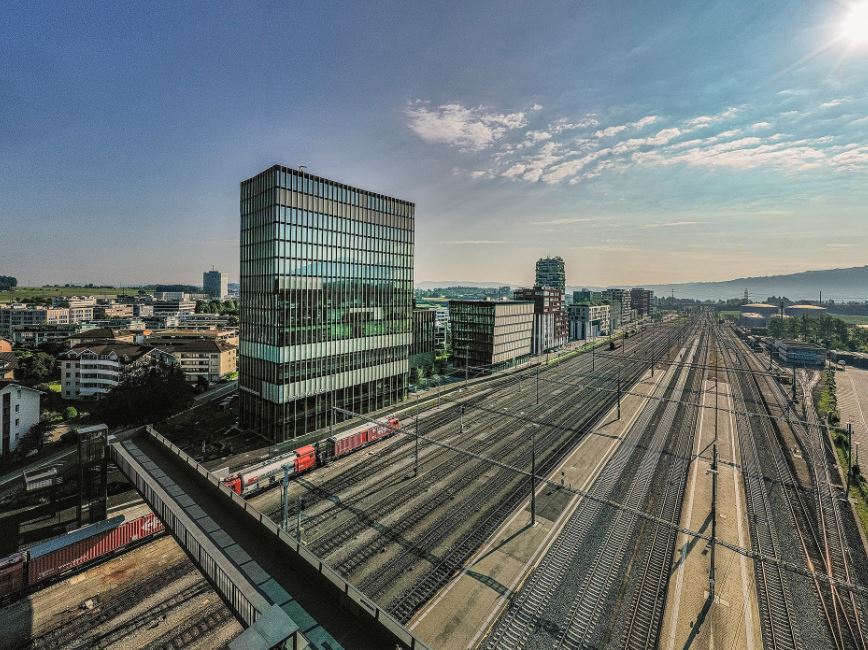Fireproof wooden skyscrapers
Building with wood is booming. The building material can be used flexibly and is also convincing in terms of sustainability. Thanks to adapted fire protection regulations, wood has also been used in high-rise construction in Switzerland for several years.

The last century was the century of concrete and steel, as most of our buildings and infrastructure impressively testify. Wood, on the other hand, eked out a niche existence for a long time - not least because of strict fire safety regulations. It may have been useful for roof trusses, or perhaps for atmospheric decoration or for a chalet in the mountains. But for large buildings, single-family homes and road bridges, concrete set the tone. In recent years, however, a clear trend reversal has emerged. Wood is celebrating its comeback and is being used in more and more buildings.
Advanced digitization
There are good reasons for this, explains Thomas Rohner, professor of timber construction and BIM at the Bern University of Applied Sciences (BFH). "Building with wood is faster, more precise, and enables greater schedule and cost reliability," he says, citing some of the advantages that benefit clients and investors. Digitalization also contributes to this, because timber structures can be excellently planned with Building Information Modeling (BIM). The timber construction industry has been working with 3D modeling for decades and, thanks to this experience, knows how to implement production data in a BIM model.
Created in modules
Another reason is the modular construction method in which most wooden structures are realized. Instead of on the construction site, specialists can prepare the individual elements to the millimeter in dry, safe and well-equipped production halls. On site, the parts are then quickly assembled. The shell also does not have to dry out, as is the case with concrete. The construction process is thus shortened, the property can be occupied earlier and thus generates rental income sooner. In the case of large projects in particular, considerable cost savings and higher revenues are possible.
Convincing service life
Using wood as a building material is not only good for your wallet, but also for the environment. Swiss wood is CO2-neutral because only as much forest is cleared as grows back. In addition, the transport distances are very short, which also leads to a reduction in emissions. Unlike many other materials, the disposal of wood at the end of its life is also unproblematic: when it is burned, no more CO2 is released than was originally incorporated. "But you don't have to dispose of it that quickly," adds Thomas Rohner. "Among building materials, wood has the longest proven service life, with the exception of natural stone."
Fire protection guaranteed
Whereas in earlier times fires could reduce entire villages and towns built of wood to rubble, modern timber construction has become very safe in terms of fire protection. In the case of high-rise buildings made of wood, those responsible develop a fire protection concept that includes, for example, consistent encapsulation of the wooden elements. "This means that if a room or apartment catches fire, the fire cannot spread to neighboring rooms," Rohner explains. The spread of a fire across the façade, as tragically happened at Grenfell Tower in London in 2017, can also be prevented with appropriate structural measures - so-called fire barriers. Speaking of fire, wood can burn, but from a structural point of view it is still safer than steel. While steel loses its strength at low fire temperatures and the structure becomes unstable, wood does not lose its strength even in the event of a superficial fire.
Highest wooden skyscraper in Switzerland
The revised Swiss Fire Protection Ordinance, which has been in force since 2015, takes into account the new findings in the handling of wood. Specifically, the requirements for fire resistance and the materialization of building components have been separated. A fire resistance of 60 minutes now applies - regardless of whether the building component is combustible or non-combustible. The only decisive factor is that it does not lose the required properties for 60 minutes in the event of fire. With this adaptation, the construction of high-rise wooden buildings became possible in Switzerland. Already in 2018, Switzerland's first high-rise wooden building was completed on the Suurstoffi site in Risch Rotkreuz ZG. In the fall of 2019, "Arbo," which belongs to the HSLU campus, was added to the site as another wooden high-rise. With its 15 floors, it towers a proud 60 meters into the air directly next to the Rotkreuz train station. This makes "Arbo" the tallest wooden high-rise in Switzerland to date.
Extinguishing system and special staircase
Fire protection is ensured by a combination of technical and structural measures: The property has full sprinkler protection and full fire alarm monitoring. This allows certain wooden components such as columns, beams and ribs to be left visible. In addition, this so-called extinguishing system principle allows the required fire resistance to be reduced from 90 to 60 minutes. This optimizes the cost-effectiveness of the fire protection measures while maintaining the same level of protection.
A safety stairwell in the concrete core of the building provides access to all floors and offers users a protected exit in case of fire. The stairwell is connected to a fire alarm system with full monitoring and is protected against smoke. When the sensors detect smoke, the stairwell is pressurized, preventing smoke from entering. The users in the "Arbo" are thus just as well protected in the event of a fire as in a conventional high-rise building made of concrete and steel.
This technical article appeared in the printed issue SicherheitsForum 2-2022. You want to read the articles of this issue?
Then close right away here a subscription.









